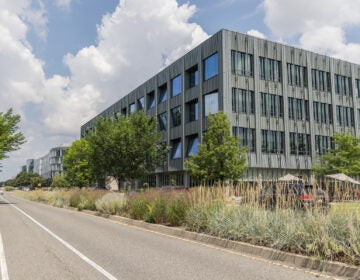Who can replace PIDC’s John Grady, mastermind of Philly’s Navy Yard?
John Grady’s departure from PIDC leaves a vacancy at the top of a powerful local institution. A successor is expected to be announced in January.

The renovated interior of a Navy Yard building. The former base was remade under the leadership of outgoing PIDC President John Grady. (PIDC)
Philadelphia economic development leader John Grady grew up in a working-class city run by people like his grandfather, a factory worker at the Exide Battery plant who eventually rose to become a prominent union leader.
Grady inherited a different Philadelphia, one defined by factories closing and families moving out of neighborhoods like Olney, where he grew up.
“The seventies and eighties were devastating decades for cities,” Grady said. “Exide closed when I was in school. Breyers Ice Cream closed when I was in school. All these banks consolidated and closed … It was devastating.”
Grady will step down from leading the Philadelphia Industrial Development Corporation at the end of this month. After 21 years at the economic development agency, he will move to Wexford Science and Technology, the Baltimore-based development firm behind the uCity Square development in University City. Grady leaves behind a legacy of revitalized post-industrial hubs including the Philadelphia Navy Yard, the 1996 closure of which Grady described as the spiritual epitome of decades of decline.
But his departure leaves a vacancy at the top of a powerful civic institution, which he has led since 2011. His successor will take the reins of an agency created in 1958 as nonprofit partnership between city government and the Chamber of Commerce of Greater Philadelphia, founded to help the region weather post-war deindustrialization.
The outgoing CEO said the PIDC board had appointed a Transition Committee and expects to announce a successor in January, The organization has a “deep, diverse and talented staff,” Grady said. Grady’s immediate VPs, like Anne Nevins, Sam Rhoads, Prema Gupta or Tom Dalfo, were his most likely successors, sources told PlanPhilly.
John Hawkins, a longtime city lobbyist and a friend of the outgoing PIDC chief, said that the agency was well positioned for an internal hire.
“He has built an impressive bench at PIDC that is the envy of most other cities, so I certainly hope that the search would begin and end with those that have been working so hard all these years to make John look good,” he said.
Grady’s ties to PIDC run deep — his labor-leader grandfather sat on the agency’s board decades before he joined the agency in 1998. The son of a school teacher and a La Salle professor, Grady entered PIDC after a decade-long stint working in Camden at the Cooper’s Ferry Development Association, a community development corporation.
“Cities were not in fashion the way they are now when I got out of school. It was hard to attract people and capital. I was interested in how cities could position themselves in the marketplace in a different way,” Grady said. “Government, development, politics and the intersection of all those things, my career grew from that.”
PIDC’s most visible success story would come to full fruition largely under Grady’s stewardship. When the federal government decided to close the Navy Yard in the 1990s, many saw the sprawling site as a city-sized albatross around the neck of South Philadelphia.
“There was a great sense of despair around that closure,” Grady said.
Efforts to reimagine the base were in the works when Grady arrived at PIDC. Two years later, in 2000, the agency took control of the site and in 2004, the agency updated a master redevelopment plan that centered around a civilian shipyard and an office park facilitated by state tax incentives. Grady established himself as the point person for the multi-decade redevelopment in the 2000s, a period that saw major tenants like Urban Outfitters relocate to the yard.
Two years after Grady moved up to the top position at PIDC, the Navy Yard would crest 10,000 jobs, more than when the base initially shut down. Today, it boasts over over $1 billion in new investment and some 160 companies to its campus. The ultimate goal is to triple those figures. In the fall, PIDC began a search for developers interested in building the former base’s first homes.
“We learned a lesson when the base closed, that having one owner can leave you in a difficult position,” Grady said. “We focused on diversification.”
The agency has, in recent years, also played a role in arranging favorable financing and other support for about 60 smaller redevelopment projects. Grady said he was equally proud of these lower-profile projects. He pointed to the $38.7 million transformation of a Kensington textile mill into affordable apartments targeted towards school teachers, known as Oxford Mills.
Asked about his biggest failure in office, Grady pointed the agency’s unsuccessful 2018 effort to lure Amazon to Philadelphia. That push cost the organization at least half a million dollars and attracted public scorn from taxpayers outraged that the city wanted to give massive tax breaks to one of the world’s most successful companies, owned by Jeff Bezos, the world’s richest man.
Grady says his biggest regret is that it didn’t work.
“We should have gotten Amazon. That would have been a big deal,” he said.
Not all have seen PIDC’s work in as positive a light. Stan Shapiro, a retired City Council staffer and vice-chair of the activist group Philadelphia Neighborhood Networks, described them as an “undemocratic” organization that represented the interests of big business over ordinary Philadelphians. He skewered the Amazon proposal as an example.
“It’s shameful that the city would be willing to send some vast sum of money to that company,” Shapiro said. “It’s a perversion of how the income stream should be flowing.”
But like him or loathe him, Grady’s departure leaves big shoes to fill, according to Hawkins.
“John Grady is one of the smartest economic development experts this city has ever seen,” Hawkins said.
Grady described a development philosophy heavily informed by the decline he observed throughout his life: a city, defined by industry, left in an existential crisis as its factories vanished and federal government support diminished. His hope now, as the city moves into its 10th year of economic growth, is to see more of these returns invested into core government services like schools and public transit.
As he reflected back on his legacy, Grady depicted himself as a realist battling massive, macro-economic forces.
“I think part of the role we play is to bring some reality and perspective from the marketplace,” he said of PIDC. “We always need to access the resources of the market to drive larger employment.”
WHYY is your source for fact-based, in-depth journalism and information. As a nonprofit organization, we rely on financial support from readers like you. Please give today.







